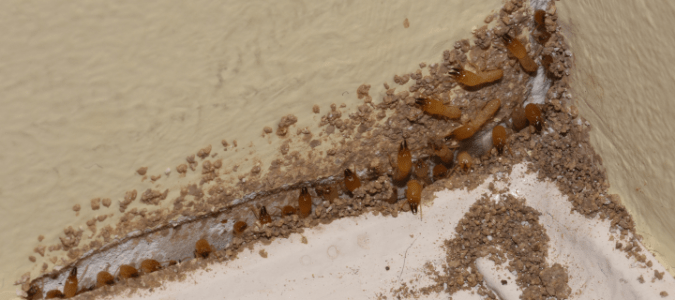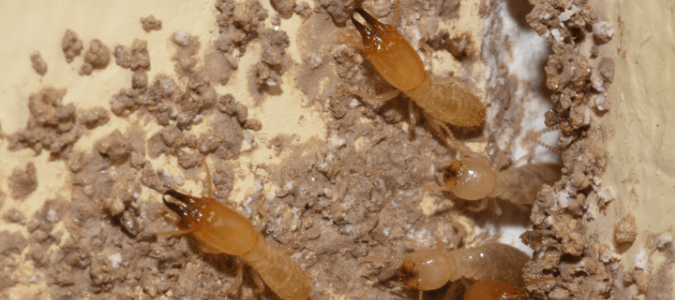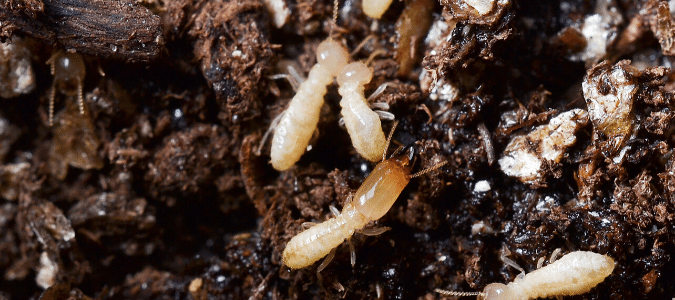Many homeowners wonder about termite season and when they should be on the lookout for these pests. The unfortunate truth is that termites can be active all year long, quietly creating damage to a home. That said, there is a stretch of time when homeowners are more likely to notice termites—when termites swarm.
When a termite nest reaches maturity, reproductive termites will fly out of the nest to go find a mate, find a place to nest and start a new colony. If you are home when a termite swarm happens, you will see these insects flying toward light sources or windows. If you aren’t home when a termite swarm happens, you may find dropped wings near windowsills and on the floor. Flying termites can easily be confused with flying ants. If you find wings around your home and you are not sure what you’re dealing with, it’s wise to contact a pest control professional.
By knowing the factors that impact when termites swarm, homeowners can be better prepared to spot the warning signs of an infestation. If you notice any signs that termites are making your home their home, contact a pest control specialist.
Generally, swarms of termites are more likely to appear between March and early fall. Several factors impact termite activity, like humidity, warmth and the species of termites.
The types of termites that homeowners in the United States are likely to encounter are subterranean and drywood termites. Subterranean termites are the first to act. They swarm early in the spring, especially after heavy rain when it is wet and humid. Formosan termites, which are an invasive species of subterranean termites, typically swarm May through July. Drywood termites typically swarm during the summer into early fall.
Termites can cause damage at any time of the year. If you spot termites on your property, contact a pest control expert to create a treatment plan.
Do Termites Come Out at Night?
Since homeowners often don’t notice they have termites until a swarm has occurred, many wonder if termites are nocturnal. The truth is that termites don’t need sleep and they are active all day, every day. However, just because they are active, it doesn’t mean you can see them. Termites are discreet insects that tunnel through wood and soil. Unless you know exactly what to look for and where to look, it can be extremely difficult to locate these pests.
Signs of Termites
As previously mentioned, many homeowners’ first sign of termites is noticing them swarm or finding discarded wings around the house. It’s important to know, though, that noticing swarms of termites is a sign of an active termite colony nearby. This does not necessarily mean the colony is on a homeowner’s property. To ensure there isn’t a colony on your property, contact a professional who can conduct a thorough inspection.
If you have found wings, you want to confirm that they are actually termite wings. Termite wings are between a quarter of an inch to three-eighths of an inch and can range in color depending on which species of termite has infested your home. Some wings are completely translucent, while others are grayish brown. Additionally, all of the wings you find will be the same length.
There are some other signs of termites, but these are trickier to spot. Noticing hollow wood can be a sign of termite activity. Knocking on your wood beams and listening for a hollow sound is one way to possibly tell whether termites have infested your home.
Another common sign of a termite infestation is if your windows and doors fit tighter than usual or if you see any bubbling paint. It may seem like the doors are warped from humidity, but it could be from termite damage.
One other sign of termites is mud tubes. Subterranean termites require moisture to survive. To travel from the moist ground to a home, they will create mud tubes to maintain a moist environment. These tubes are often about the color and width of a pencil but can vary.
A professional can conduct a thorough inspection of your home and yard. They can confirm whether or not termites are present on your property.
What Do Termites Hate?
Homeowners often want to take matters into their own hands to deal with a termite infestation. Several DIY treatments claim to get rid of termites by using scents that termites hate, such as garlic, cloves and cinnamon. While it would be great if there were household items you could use to control termites, these options do not work. Subterranean termites live underground in a nest with complex tunneling systems. Even if this treatment worked on the termites you did see, there would still be a whole colony living underneath you.
Termites can cause structural damage to your home, so an infestation should not be taken likely. Calling in professional pest control services is the best way to go.
If you want to be a proactive homeowner, the best thing you can do is make your home less hospitable for termites. Fix any leaks and drainage issues to reduce moisture in your home. Ensure that gutters point away from your home and that moisture doesn’t pool around your home’s exterior.
Keep firewood lifted off the ground, and do not stack wood piles against your house. If you use mulch in your garden, be sure to keep the mulch away from the exterior of your home.
Termites can be extremely damaging pests. They are active 24/7 and can cause damage anytime throughout the year, so homeowners must stay vigilant.
It may be tempting to try DIY solutions to deal with termites, but the best thing you can do is work with a pest control expert. If you see termites or signs of an infestation, such as discarded wings, contact a professional pest control service.
ABC Can Treat the Termites on Your Property
Finding termites on your property can be frightening. These pests are destructive, and their colonies can hold a million members. If you believe you have termites on your property, contact ABC Home & Commercial Services. Our professionals will be able to locate the termite colony and then implement an effective pest control plan. Whether you have drywood or subterranean termites, we can help.



